Gebali F. Analysis Of Computer And Communication Networks
Подождите немного. Документ загружается.

13.8 Switch Performance Measures 491
start getting lost. This situation typically gets worse since the receiver will start
sending negative acknowledgments and the sender will start retransmitting the lost
frames. This leads to more packets in the network and the overall performance starts
to deteriorate [7]. Traffic management protocols must be implemented at the routers
to ensure that users do not tax the resources of the network. Examples of traffic
management protocols are leaky bucket, token bucket, and admission control tech-
niques. Chapter 8 discusses the traffic management protocols in more detail.
13.7.3 Scheduling
Routers must employ scheduling algorithms for two reasons: to provide different
quality of service (QoS) to the different types of users and to protect well-behaved
users from misbehaving users that might hog the system resources (bandwidth and
buffer space). A scheduling algorithm might operate on a per-flow basis or it could
aggregate several users into broad service classes to reduce the workload. Chapter 12
discusses scheduling techniques in more detail.
13.7.4 Congestion Control
The switch or router drops packets to reduce network congestion and to improve its
efficiency. The switch must select which packet to drop when the system resources
become overloaded. There are several options such as dropping packets that arrive
after the buffer reaches a certain level of occupancy (this is known as tail dropping).
Another option is to drop packets from any place in the buffer depending on their
tag or priority. Chapter 12 discusses packet dropping techniques in more detail.
13.8 Switch Performance Measures
Many switch designs have been proposed and our intention here is not to review
them but to discuss the implications of the designer’s decisions on the overall perfor-
mance of the switch. This, we believe, is crucial if we are to produce novel switches
capable of supporting terabit communications.
The basic performance measures of a switch are as follows:
1. Maximum data rate at the inputs.
2. The number of input and output ports.
3. The number of independent logical channels or calls it can support.
4. The average delay a packet encounters while going through the switch.
5. The average packet loss rate within the switch.
6. Support of different quality of service (QoS) classes, where QoS includes data
rate (bandwidth), packet delay, delay variation (jitter), and packet loss.
7. Support of multicast and broadcast services.
492 13 Switches and Routers
8. Scalability of the switch, which refers to the ability of the switch to work sat-
isfactorily if the line data rates are scaled up or if the number of inputs and
outputs is scaled up.
9. The capacity (packets/s or bits/s) of the switch is defined as
Switch capacity = input line rate ×number of input ports (13.1)
10. Flexibility of the switch architecture to be able to upgrade its components. For
example, we might be interested in upgrading the input/output line cards or we
might want to replace only the switch fabric.
13.9 Switch Classifications
The two most important components of a switch are its buffers and its switching
fabric. Based on that we can describe the architecture of a switch based on the
following two criteria:
• The type of switch fabric (SF) used in the switch to route packets from the switch
inputs (ingress points) to the switch outputs (egress points). Detailed qualitative
and quantitative discussion of switch fabrics, also known as interconnection net-
works, is found in Chapter 14.
• Location of the buffers and queues within the switch. An important characteristic
of a switch is the number and location of the buffers used to store incoming
traffic for processing. The placement of the buffers and queues in a switch is of
utmost importance since it will impact the switch performance measures such as
packet loss, speed, ability to support differentiated services, etc. The following
sections discuss the different buffering strategies employed and the advantages
and disadvantages of each option. Chapter 15 provides qualitative discussion of
the performance parameters of the different switch types.
The remainder of this chapter and Chapter 16 discuss the different design options
for switch buffering. Chapter 14 discusses the different possible design options for
interconnection networks.
13.10 Input Queuing Switch
Figure 13.8 shows an input queuing switch. Each input port has a dedicated FIFO
buffer to store incoming packets. The arriving packets are stored at the tail of the
queue and only move up when the packet at the head of the queue is routed through
the switching fabric to the correct output port. A controller at each input port classi-
fies each packet by examining its header to determine the appropriate path through
the switch fabric. The controller must also perform traffic management functions.
In one time step, an input queue must be able to support one write and one read
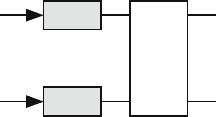
13.10 Input Queuing Switch 493
Fig. 13.8 Input queuing
switch. Each input has a
queue for storing incoming
packets
SF
Input
Buffers
N
1
N
1
...
...
operations which is a nice feature since the memory access time is not likely to
impose any speed bottlenecks.
Assuming an N × N switch, the switch fabric (SF) must connect N input ports
to N output ports. Only a space division N × N switch can provide simultaneous
connectivity.
The main advantages of input queuing are
1. Low memory speed requirement.
2. Distributed traffic management at each input port.
3. Distributed table lookup at each input port.
4. Support of broadcast and multicast does not require duplicating the data.
Distributed control increases the time available for the controller to implement its
functions since the number of sessions is limited at each input. Thus input queuing
is attractive for very high bandwidth switches because all components of the switch
can run at the line rate [8].
The main disadvantages of input queuing are
1. Head of line (HOL) problem, as discussed below
2. Difficulty in implementing data broadcast or multicast since this will further slow
down the switch due to the multiplication of HOL problem
3. Difficulty in implementing QoS or differentiated services support, as discussed
below
4. Difficulty in implementing scheduling strategies since this involves extensive
communications between the input ports
HOL problem arises when the packet at the head of the queue is blocked from
accessing the desired output port [9]. This blockage could arise because the switch
fabric cannot provide a path (internal blocking) or if another packet is accessing the
output port (output blocking). When HOL occurs, other packets that may be queued
behind the blocked packet are consequently blocked from reaching possibly idle
output ports. Thus HOL limits the maximum throughput of the switch [10]. A de-
tailed discrete-time queuing analysis is provided in Section 15.2 and the maximum
throughput is not necessarily limited to this figure.
The switch throughput can be increased if the queue service discipline examines
a window of w packets at the head of the queue, instead of only the HOL packet.
The first packet out of the top w packets that can be routed is selected and the queue
size decreases by one such that each queue sends only one packet to the switching
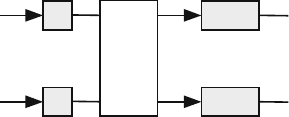
494 13 Switches and Routers
fabric. To achieve multicast in an input queuing switch, the HOL packet must remain
at the head of the queue until all the multicast ports have received their own copies at
different time steps. Needless to say, this aggravates the HOL problem since now we
must deal with multiple blocking possibilities for the HOL packet before it finally
leaves the queue. Alternatively, the HOL packet might make use of the multicast
capability of the switching fabric if one exists.
Packet scheduling is difficult because the scheduler has to scan all the packets in
all the input ports. This requires communication between all the inputs which limits
the speed of the switch. The scheduler will find it difficult to maintain bandwidth
and buffer space fairness when all the packets from different classes are stored at
different buffers at the inputs. For example, packets belonging to a certain class of
service could be found in different input buffers. We have to keep a tally of the
buffer space used up by this service class.
In input queuing, there are three potential causes for packet loss:
1. Input queue is full. An arriving packet has no place in the queue and is discarded.
2. Internal blocking. A packet being routed within the switch fabric is blocked in-
side the SF and is discarded. Of course, this type of loss occurs only if the input
queue sends the packet to the SF without waiting to verify that a path can be
provided.
3. Output blocking. A packet that made it through the SF reaches the desired output
port but the port ignores it since it is busy serving another packet. Again, this
type of loss occurs only if the input queue sends the packet to the output without
waiting to verify that the output link is available.
13.11 Output Queuing Switch
To overcome the HOL limitations of input queuing, the standard approach is to aban-
don input queuing and place the buffers at the output ports as shown in Fig. 13.9.
Notice, however, that an output queuing switch must have small buffers at its inputs
to be able to temporarily hold the arriving packets while they are being classified
and processed for routing.
An incoming packet is stored at the input buffer and the input controller must read
the header information to determine which output queue is to be updated. The packet
must be routed through the switch fabric to the correct output port. The controller
Fig. 13.9 Output queuing
switch. Each output has a
queue for storing the packets
destined to that output. Each
input must also have a small
FIFO buffer for storing
incoming packets for
classification
SF
Small Input
Buffers
N
1
N
1
...
...
Main Output
Buffers
13.11 Output Queuing Switch 495
must also handle any contention issues that might arise if the packet is blocked from
leaving the buffer for any reason.
A controller at each input port classifies each packet by examining the header to
determine the appropriate path through the switch fabric. The controller must also
perform traffic management functions.
In one time step, the small input queue must be able to support one write and one
read operations which is a nice feature since the memory access time is not likely
to impose any speed bottlenecks. However, in one time step, the main buffer at each
output port must support N write and one read operations.
Assuming an N × N switch, the switch fabric (SF) must connect N input ports
to N output ports. Only a space division N × N switch can provide simultaneous
connectivity.
The main advantages of output queuing are
1. Distributed traffic management
2. Distributed table lookup at each input port
3. Ease of implementing QoS or differentiated services support
4. Ease of implementing distributed packet scheduling at each output port
The main disadvantages of output queuing are
1. High memory speed requirements for the output queues.
2. Difficulty of implementing data broadcast or multicast since this will further
slow down the switch due to the multiplication of HOL problem.
3. Support of broadcast and multicast requires duplicating the same data at different
buffers associated with each output port.
4. HOL problem is still present since the switch has input queues.
The switch throughput can be increased if the switching fabric can deliver more
than one packet to any output queue instead of only one. This can be done by
increasing the operating speed of the switch fabric which is known as speedup.
Alternatively, the switch fabric could be augmented using duplicate paths or by
choosing a switch fabric that inherently has more than one link to any output port.
When this happens, the output queue has to be able to handle the extra traffic by
increasing its operating speed or by providing separate queues for each incoming
link.
As we mentioned before, output queuing requires that each output queue must
be able to support one read and N write operations in one time step. This, of course,
could become a speed bottleneck due to cycle time limitations of current memory
technologies.
To achieve multicast in an output queuing switch, the packet at an input buffer
must remain in the buffer until all the multicast ports have received their own copies
at different time steps. Needless to say, this leads to increased buffer occupancy
since now we must deal with multiple blocking possibilities for the packet before it
finally leaves the buffer. Alternatively, the packet might make use of the multicast
capability of the switching fabric if one exists.
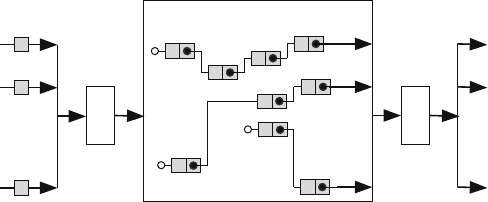
496 13 Switches and Routers
In output queuing, there are four potential causes for packet loss:
1. Input buffer is full. An arriving packet has no place in the buffer and is discarded.
2. Internal blocking. A packet being routed within the switch fabric is blocked in-
side the SF and is discarded.
3. Output blocking. A packet that made it through the SF reaches the desired output
port but the port ignores it since it is busy serving another packet.
4. Output queue is full. An arriving packet has no place in the queue and is
discarded.
13.12 Shared Buffer Switch
Figure 13.10 shows a shared buffer switch design that employs a single common
buffer in which all arriving packets are stored. This buffer queues the data in separate
queues that are located within one common memory. Each queue is associated with
an output port. Similar to input and output queuing, each input port needs a local
buffer of its own in which to store incoming packets until the controller is able to
classify them.
A flexible mechanism employed to construct queues using a regular random-
access memory is to use the linked list data structure. Each linked list is dedicated
to an output port. In a linked list, each storage location stores a packet and a pointer
to the next packet in the queue as shown. Successive packets need not be stored in
successive memory locations. All that is required is to be able to know the address
of the next packet though the pointer associated with the packet. This pointer is
indicated by the solid circles in the figure. The lengths of the linked lists need not
be equal and depend only on how many packets are stored in each linked list. The
memory controller keeps track of the location of the last packet in each queue, as
shown by the empty circles. There is no need for a switch fabric since the packets
are effectively “routed” by being stored in the proper linked list.
When a new packet arrives at an input port, the buffer controller decides which
queue it should go to and stores the packet at any available location in the memory,
N
1
Shared Buffer
Write
Controller
2
N
1
2
Inputs Outputs
Read
Controller
N
1
2
Fig. 13.10 Shared buffer switch. Solid circles indicate next packet pointers. Empty circles indicate
pointers to the tail end of each linked list
13.13 Multiple Input Queuing Switch 497
then appends that packet to the linked list by updating the necessary pointers. When
a packet leaves a queue, the pointer of the next packet now points to the output port
and the length of the linked list is reduced by one.
The main advantages of shared buffering are
1. Ability to assign different buffer space for each output port since the linked list
size is flexible and limited only by the amount of free space in the shared buffer.
2. A switching fabric is not required.
3. Distributed table lookup at each input port.
4. There is no HOL problem in shared buffer switch since each linked list is dedi-
cated to one output port.
5. Ease of implementing data broadcast or multicast.
6. Ease of implementing QoS and differentiated services support.
7. Ease of implementing scheduling algorithms at each linked list.
The main disadvantages of shared buffering are
1. High memory speed requirements for the shared buffer.
2. Centralized scheduler function implementation which might slow down the
switch.
3. Support of broadcast and multicast requires duplicating the same data at different
linked lists associated with each output port.
4. The use of a single shared buffer makes the task of accessing the memory
very difficult for implementing scheduling algorithms, traffic management al-
gorithms, and QoS support.
The shared buffer must operate at a speed of at least 2N since it must perform a
maximum of N write and N read operations at each time step.
To achieve multicast in a shared buffer switch, the packet must be duplicated
in all the linked lists on the multicast list. This needlessly consumes storage area
that could otherwise be used. To support differentiated services, the switch must
maintain several queues at each input port for each service class being supported.
In shared buffering, there are two potential causes for packet loss:
1. Input buffer is full. An arriving packet has no place in the buffer and is discarded.
2. Shared buffer is full. An arriving packet has no place in the buffer and is
discarded.
13.13 Multiple Input Queuing Switch
To overcome the HOL problem in input queuing switch and still retain the advan-
tages of that switch, m input queues are assigned to each input port as shown in
Fig. 13.11. If each input port has a queue that is dedicated to an output port (i.e.,
m = N), the switch is called virtual output queuing (VOQ) switch. In that case,
the input controller at each input port will classify an arriving packet and place it in
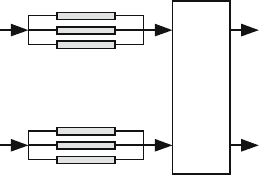
498 13 Switches and Routers
Fig. 13.11 Multiple input
queue switch. Each input port
has a bank of FIFO buffers.
The number of queues per
input port could represent the
number of service classes
supported or it could
represent the number of
output ports
SF
Input
Queues
N
1
N
1
...
...
1: m
1: m
the FIFO buffer belonging to the destination output port. In effect, we are creating
output queues at each input and hence the name “virtual output queuing”.
This approach removes the HOL problem and the switch efficiency starts to
approach 100% depending only on the efficiency of the switch fabric and the
scheduling algorithm at each output port. Multicast is also very easily supported
since copies of an arriving packet could be placed at the respective output queues.
Distributed packet classification and traffic management are easily implemented in
that switch also.
There are, however, several residual problems with this architecture. Scheduling
packets for a certain output port becomes a major problem. Each output port must
choose a packet from N virtual queues located at N input ports. This problem is
solved in the VRQ switch that is discussed in Section 13.16 and Chapter 16. Another
disadvantage associated with multiple input queues is the contention between all the
queues to access the switching fabric. Dedicating a direct connection between each
queue and the switch fabric results in a huge SF that is of dimension N
2
× N which
is definitely not practical.
In multiple input queuing, there are three potential causes for packet loss:
1. Input buffer is full. An arriving packet has no place in the buffer and is discarded.
2. Internal blocking. A packet being routed within the switch fabric is blocked in-
side the SF and is discarded.
3. Output blocking. A packet that made it through the SF reaches the desired output
port but the port ignores it since it is busy serving another packet.
13.14 Multiple Output Queuing Switch
To support sophisticated scheduling algorithms, n output queues are assigned to
each output port as shown in Fig. 13.12. If each output port has a queue that is
dedicated to an input port (i.e., n = N), the switch is called virtual input queuing
(VIQ) switch. In that case, the output controller at each output port will classify an
arriving packet and place it in the FIFO buffer belonging to the input port it came on.
In effect, we are creating input queues at each output and hence the name “virtual
input queuing”. Another advantage of using several output queues is that the FIFO
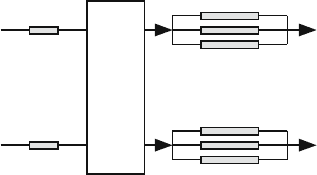
13.15 Multiple Input/Output Queuing Switch 499
Fig. 13.12 Multiple output
queuing switch. Each output
port has bank of FIFO
buffers. The number of
queues per output port could
represent the number of
service classes supported or it
could represent the number of
connections supported
SF
N
1
N
1
...
...
Output
Queues
1: n
1: n
speed need not be N times the line rate as was the case in output queuing switch
with a single buffer per port.
Several disadvantages are not removed from output queue switch using this ap-
proach. The HOL problem is still present and packet broadcast still aggravates the
HOL problem. Another disadvantage associated with multiple output queues is the
contention between all the queues to access the switching fabric. Dedicating a direct
connection between each queue and the switch fabric results in a huge SF that is of
dimension N × N
2
, which is definitely not practical. This problem is solved in the
VRQ switch that is discussed in Section 13.16 and Chapter 16.
In multiple output queuing, there are four potential causes for packet loss:
1. Input buffer is full. An arriving packet has no place in the buffer and is discarded.
2. Internal blocking. A packet being routed within the switch fabric is blocked in-
side the SF and is discarded.
3. Output blocking. A packet that made it through the SF reaches the desired output
port but the port ignores it since it is busy serving another packet.
4. Output queue is full. An arriving packet has no place in the queue and is dis-
carded.
13.15 Multiple Input/Output Queuing Switch
To retain the advantages of multiple input and multiple output queuing and avoid
their limitations, multiple queues could be placed at each input and output port as
shown in Fig. 13.13. An arriving packet must be classified by the input controller at
each input port to be placed in its proper input queue. Packets destined to a certain
output port travel through the switch fabric (SF), and the controller at each output
port classifies them, according to their class of service, and places them in their
proper output queue.
The advantages of multiple queues at the input and the output are removal of
HOL problem, distributed table lookup, distributed traffic management, and ease of
implementation of differentiated services. Furthermore, the memory speed of each
queue could match the line rate.
The disadvantage of the multiple input and output queue switch is the need to
design a switch fabric that is able to support a maximum of N
2
× N
2
connections
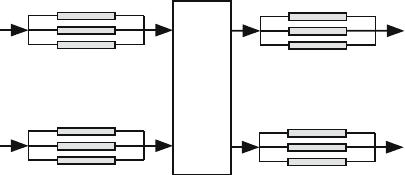
500 13 Switches and Routers
Fig. 13.13 Multiple input
and output queuing switch.
Each input port has bank of
FIFO buffers and each output
port has bank of FIFO buffers
SF
Input
Queues
N
1
...
1: m
1: m
Output
Queues
N
1
...
1: n
1: n
simultaneously. This problem is solved in the VRQ switch that is discussed in Sec-
tion 13.16 and Chapter 16.
In multiple input and output queuing, there are four potential causes for packet
loss:
1. Input buffer is full. An arriving packet has no place in the buffer and is discarded.
2. Internal blocking. A packet being routed within the switch fabric is blocked in-
side the SF and is discarded.
3. Output blocking. A packet that made it through the SF reaches the desired output
port but the port ignores it since it is busy serving another packet.
4. Output queue is full. An arriving packet has no place in the queue and is
discarded.
13.16 Virtual Routing/Virtual Queuing (VRQ) Switch
We saw in the previous sections the many alternatives for locating and segmenting
the buffers. Each design had its advantages and disadvantages. The virtual rout-
ing/virtual queuing (VRQ) switch has been proposed by the author such that it has
all the advantages of earlier switches but none of their disadvantages. In addition,
the design has extra features such as low power, scalability, etc. [11–13].
A more detailed discussion of the design and operation of the virtual rout-
ing/virtual queuing (VRQ) switch is found in Chapter 16. Figure 13.14 shows the
main components of that switch. Each input port has N buffers (not queues) where
incoming packets are stored after being classified. Similarly, each output port has K
FIFO queues, where K is determined by the number of service classes or sessions
that must be supported. The switch fabric (SF) is an array of backplane buses. This
gives the best throughput compared to any other previously proposed SF architecture
including crossbar switches.
The input buffers store incoming packets which could be variable in size. The
input controller determines which output port is desired by the packet and sends
a pointer to the destination output port. The pointer indicates to the output port
the location of the packet in the input buffer, which input port it came from, and
any other QoS requirements. The output controller queues that pointer—The packet
